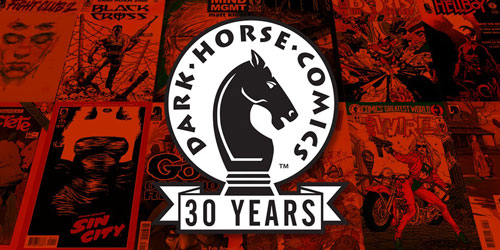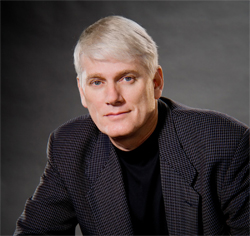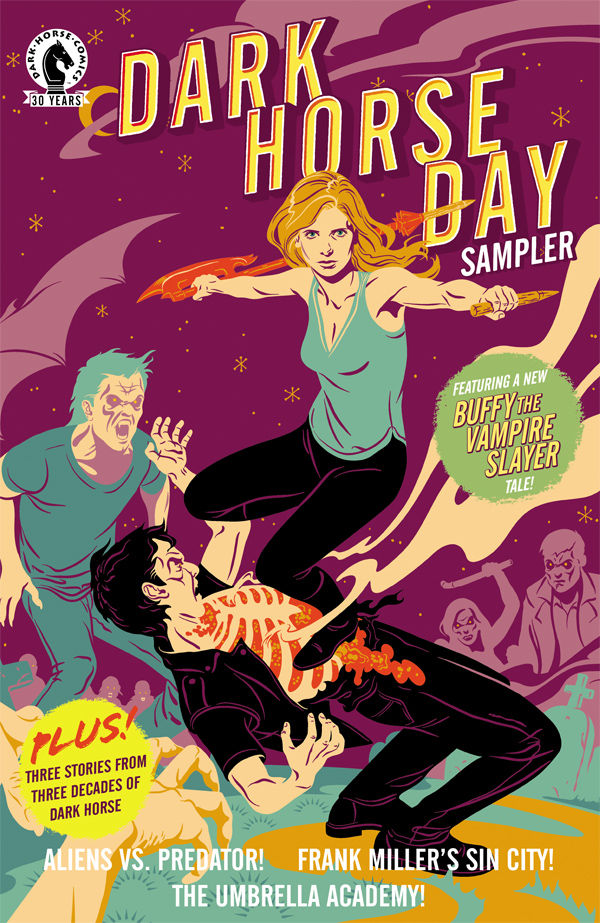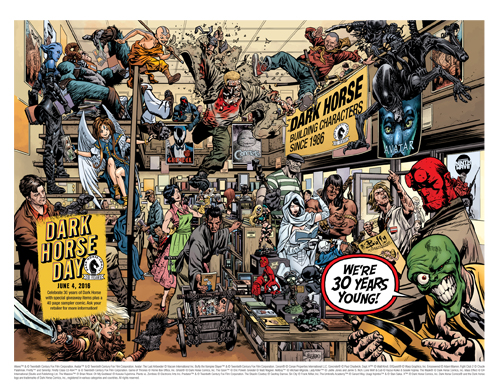Mike Richardson Look Back On 30 Years of Dark Horse Comics
Apr 04, 2016

Dark Horse Comics celebrates its 30th Anniversary in 2016. The publisher will commemorate the anniversary with a special Dark Horse Day on Saturday, June 4th at your local comic shop! See a list of participating stores here!
PREVIEWSworld had the honor of talking with founder/publisher Mike Richardson about Dark Horse's 30 years of publishing some of the most popular comics in the industry.
PREVIEWSworld: First off, congratulations on a spectacular three decades for Dark Horse! It’s been exciting to see the company grow and change throughout the years and see its impact on the comic industry. Can you give our readers a bit of history of how DH has evolved throughout its tenure? Why do you feel Dark Horse has become such a cornerstone of the comics industry?
Mike Richardson: Well, the company initially evolved out of my retail stores (it seems like yesterday). I had been unhappy with much of what was being published at the time. I also hated the idea of artists and writers losing control of the intellectual properties they created. I was an art major and had been working as a commercial artist at the time and identified with the creative community. I decided to publish a comic with original material owned by the people who actually did the work. Dark Horse Presents #1 sold fifty thousand copies, and we were off and running. The company initially consisted of Randy Stradley, who quit his job with the LA Times when I told him about my new project, and myself. We pasted the first issue up on the counter of my Beaverton store. Dark Horse grew steadily and added both people and publishing projects as time passed. Now we have about 150 full-time employees working in our related divisions. We’ve evolved over the years, and now we have toy, Internet, digital, and film divisions, not to mention our original retail group. I think we’ve succeeded because we’ve done our best to respect the creators we work with and worked hard to offer quality publications and products at a reasonable price. I think also that we understand the retailers in the direct market because we’ve been retailers since I opened my first store in Bend, Oregon, on January 1, 1980.
 PREVIEWSworld: Who were the main people involved in the early setup and creation of Dark Horse? Do you remember fondly those early days?
PREVIEWSworld: Who were the main people involved in the early setup and creation of Dark Horse? Do you remember fondly those early days?
Mike Richardson: Once I had decided to start the comics company, I created a plan addressing whatever elements I thought I needed. I had met some talented comics people through my retail store, and they had gotten me to join a kind of fanzine called APA-5, which focused on comics. As a result, I met Randy Stradley (who had actually introduced me to the APA), Chris Warner, Paul Chadwick, Randy Emberlin, and others who ended up working in comics. I had a close friend named Bob Wisner who helped set me up with a local printer. Richard Finn, who owned Second Genesis, agreed to distribute the books I planned to publish. I had been doing commercial art jobs since I was in college and used local artists for the jobs I was too busy to take on. I’d planned to start a graphic arts shop that I was going to call Dark Horse Graphics. When I made the decision to start the publishing company, we held a contest at the store to name the comics company. I didn’t like any of the entries much and ended up using the Dark Horse name. In those days, I owned a restaurant, and I invited Randy Stradley, Chris Warner, and Randy Emberlin for dinner and told them I was starting a comic company. That meeting was the beginning of Dark Horse Presents #1. A short time later, I had this idea to create a character who destroyed all of the adjective-adjective-adjective-noun characters ripping off the Turtles. We ended up using a cute bear drawn by another APA-5 alumnus, Jim Smith. Boris the Bear was born, and we had our second hit.
PREVIEWSworld: What was the first licensed property developed by Dark Horse?
Mike Richardson: I always used to claim credit for our first licensed book, but I also said that it was Randy Stradley stomping around the office as though he were destroying cities who was responsible for the inspiration. Godzilla was our first licensed book. Steve Bissette was the original artist, but when the book fell behind schedule, Art Nichols did his best Bissette art imitation to finish it. Imagine our dismay when the printed book arrived, and we found the printer had left the black plate off the cover. Godzilla was nearly unrecognizable. Luckily we were able to get a second printing done quickly. We handed out a few of the misprints as a “collector’s item” and destroyed the rest.
PREVIEWSworld: Licensed properties like Star Wars, Aliens, Predator, Tomb Raider, Mass Effect, etc., have been an integral part of DHC’s publishing efforts for years. How important are these properties to DHC’s overall success?
Mike Richardson: Dark Horse didn’t start out with decades of Superman or Fantastic Four history to bank on. It occurred to us that there were well-recognized characters from films that could help shorten the learning curve of fans who seemed to flock to those characters they knew. Godzilla was a modest success for us, selling in the thirty- to forty-thousand range. We were encouraged by those numbers, but our second licensed project probably changed the entire industry’s attitude toward licensed comics forever. Twentieth Century Fox’s Aliens was a monster hit, selling over one hundred thousand copies, and was responsible for bringing scores of noncomics people into the direct market. That success led to Predator, which led to the biggest of them all, Aliens vs. Predator. AVP started a whole boom, for better or worse, in team-up books from the so-called independents, as well as more than a dozen team-ups between Dark Horse and DC. In the early days of Dark Horse, the licensed books really underwrote many of our deals. Because we had a strong certainty of financial success with our licensed comics, we could be more adventurous with our creator-owned negotiations. Things have changed with the slow erosion of comics sales, and that security blanket is not there like it used to be. However, licensed material is still a very strong category for us; it just may branch out into areas other than comic books and graphic novels.
PREVIEWSworld: You’ve been at the forefront of creators’ rights since the beginning of your company. What sets Dark Horse apart from other publishers in that regard?
Mike Richardson: I think that in 2016 comics creators have more choices than ever. Different publishers offer different types of deals, and a talented creator can probably find a deal that makes sense. At Dark Horse, we try to negotiate a deal in which both parties can benefit. We try to be sensitive to their needs as well as our own. The market is tough right now, so we have to be very creative in trying to find ways to incentivize creators to bring us their books.
PREVIEWSworld: With “comic book movies” being so popular at present, are there currently any Dark Horse properties being groomed for the movies?
Mike Richardson: We’ve been involved with film and television production almost from the beginning. Our first greenlit project, Largo’s Dr. Giggles, was released in 1992. Since then we’ve produced thirty filmed projects through Dark Horse Entertainment. Currently we are producers on the comics-based Dark Matter series, which will be going into a second season on the SyFy channel, and the upcoming Legend of Tarzan, a project I brought into Warner Bros. more than a decade ago. We recently signed a deal with Universal Cable Productions and have a number of projects in development there, including Harrow County, The Umbrella Academy, and Concrete.
 PREVIEWSworld: DHC continues to bring some of the most unique and challenging manga titles to comics. How does your manga team go about selecting series to pursue and ultimately translate and present to Western audiences?
PREVIEWSworld: DHC continues to bring some of the most unique and challenging manga titles to comics. How does your manga team go about selecting series to pursue and ultimately translate and present to Western audiences?
Mike Richardson: First of all, we work closely with our Japanese partners, a practice that goes back to the late ’80s. In those early days of Dark Horse, I would fly to Japan once or twice a year and end up in a bookstore in Tokyo, picking books by going through the manga section for hours. Toren Smith of Studio Proteus partnered with us a short time later and not only helped track down the books I was interested in publishing, but made suggestions of his own. Now we have manga specialists in Michael Gombos and Carl Horn. They are immersed in the manga and anime scene, and they make suggestions as to which books are a good fit for Dark Horse. We continue to partner with some of Japan’s greatest creators, a list that includes superstars such as CLAMP as well as legends such as Kazuo Koike and Yoshitaka Amano.
PREVIEWSworld: What’s the “next big thing” from Dark Horse? What are you personally excited about coming from Dark Horse in 2016?
Mike Richardson: Well, it seems as though we’re always getting ready to announce something big. Personally I’m excited about James Cameron’s Avatar, which will be premiering late this year. We’re working directly with Jim and Jon Landau, so it will be more than just a licensed project. With the three movies scheduled, it should be great fun for us, as well as a great series for retailers. We’ll have an amazing incentive program for retailers. I’m also excited about Gail Simone’s new creator-owned project, Wonderfall, which is scheduled as an ongoing series premiering in 2016. I’m a big fan of Gail’s and feeling really good about her latest work being here at Dark Horse. Of course, bringing Moebius Library to our company is something I’m very proud of, and I’m looking forward to its October release. There’s also a huge Neil Gaiman project that I’m probably going to get in trouble for even mentioning here.
PREVIEWSworld: For retailers, how do you plan on celebrating the anniversary this year? Any special events planned?
Mike Richardson: We have some fun programs set. For instance, we’re releasing a yearlong series of special variant covers harking back to the comic that put us on the map, Dark Horse Presents. Over the course of 2016 we’ll be using the original DHP dress on one notable title per month. Each cover will be slightly different, as we’re highlighting the various incarnations of the anthology’s design over the years. We’ve also put together a special event called Dark Horse Day on June 4, which is a celebration of our thirty years of publishing. We’re inviting all our retailer partners to come onboard and celebrate with us. We’re offering backlist discounts, special promotional materials, and an exclusive Dark Horse Day forty-page sampler comic (see pages 2–3 of our section in this month’s catalog for more information). We have another program we’re putting the finishing touches on that we hope to have more information about very soon. As usual, month to month we’ll be sending out full-issue PDFs to retailers of our #1 issues, as well as ashcans of select titles throughout the year. We’re going to do our best to try to engage with retailers in a closer way this year—after all, they’re on the ground level, and we need to do whatever we can to support them.





